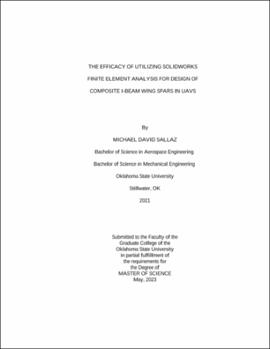| dc.contributor.advisor | Arena, Andrew | |
| dc.contributor.author | Sallaz, Michael David | |
| dc.date.accessioned | 2023-08-25T20:06:28Z | |
| dc.date.available | 2023-08-25T20:06:28Z | |
| dc.date.issued | 2023-05 | |
| dc.identifier.uri | https://hdl.handle.net/11244/338958 | |
| dc.description.abstract | Labs in which unmanned composite aircraft are produced by Oklahoma State University currently lack the capability to adequately analyze wing structural designs computationally. This is especially true regarding the design of the main composite wing spar. Within these labs, utilization of SolidWorks for modeling and CFD analysis of designs to be built is commonplace. It would be advantageous to capitalize on this familiarity with SolidWorks to extend pre-prototype analysis capabilities by utilizing the SolidWorks FEA package to analyze wing spars designed for both graduate level and undergraduate capstone projects. Proof of good correlation between experimental 3-Point Bending testing and FEA results for these composite spars would allow for further pre-prototype structural refinement, thus reducing the man hours and material costs associated with the prototyping phase. To this end, this research endeavor seeks to determine the feasibility of various Finite Element Modeling techniques through direct comparison of FEA results with both experimentation and existing Beam Theory methods. Initial baseline testing of isotropic aluminum beams established the proper procedures for boundary and loading condition application as well as for model meshing. Results from these baseline tests further established that SolidWorks FEA is capable of predicting deflection, bending stress, and shear stress to within ~16%, ~8%, and ~13% on average, respectively. Main testing of the composite I-beams revealed that both fully orthotropic FEA models and existing Beam Theory models struggled to correctly predict experimental deflection of the I-beams, with percent errors of ~81% and ~89%, respectively. In addition, the orthotropic models also struggled to replicate measured strains. Due to stress concentrations present in these FEA solutions at the locations of the supports and the applied load, errors here exceeded 130%. Similar orthotropic model performance was confirmed in other FEA programs such as Ansys. Ultimately, utilization of a modeling method by which the composite and orthotropic nature of the I-beams are reduced to an equivalent isotropic representation produced the best beam deflection solution at an average error of ~8% with experimentation. Prediction of bending and shear stresses with this idealizing method were consistent with the performance of existing Beam Theory analysis tools. | |
| dc.format | application/pdf | |
| dc.language | en_US | |
| dc.rights | Copyright is held by the author who has granted the Oklahoma State University Library the non-exclusive right to share this material in its institutional repository. Contact Digital Library Services at lib-dls@okstate.edu or 405-744-9161 for the permission policy on the use, reproduction or distribution of this material. | |
| dc.title | Efficacy of utilizing SolidWorks Finite Element Analysis for design of composite I-beam wing spars in UAVs | |
| dc.contributor.committeeMember | Conner, Joseph | |
| dc.contributor.committeeMember | Paul, Ryan | |
| osu.filename | Sallaz_okstate_0664M_18061.pdf | |
| osu.accesstype | Open Access | |
| dc.type.genre | Thesis | |
| dc.type.material | Text | |
| dc.subject.keywords | composite | |
| dc.subject.keywords | FEA | |
| dc.subject.keywords | orthotropic | |
| dc.subject.keywords | solidworks | |
| dc.subject.keywords | structural analysis | |
| dc.subject.keywords | UAV | |
| thesis.degree.discipline | Mechanical and Aerospace Engineering | |
| thesis.degree.grantor | Oklahoma State University | |
